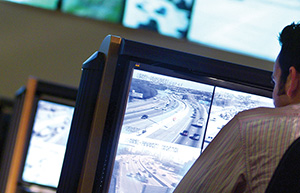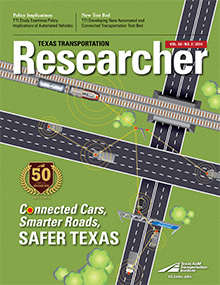Thanks to a successful prototype demonstration, researchers with the Texas A&M Transportation Institute (TTI) contributed to the growing evidence that a roadway can indeed become one big communications system. Vehicles, the roadside and traffic management centers (TMCs) can communicate with one another, seamlessly and nearly instantaneously.

The demonstration was conducted May 6–7 in Columbus, Ohio, the hometown of the Battelle Memorial Institute. Working collaboratively, Battelle integrated TTI-developed algorithms into a vehicle-based system and corresponding display. TTI then produced simulated traffic data that were fed into the system, resulting in the successful display of simulated warnings and speed recommendations as generated by the algorithms, just like the messages that would be sent in an actual connected transportation system.
Analysts believe that within the next 20 years — when all vehicles, roadside infrastructure and TMCs are able to communicate with each other — crashes, congestion and fuel consumption will all be significantly reduced.
“For this project, we developed what’s called a queue-warning algorithm, which is used to send a wireless, queue-warning message from a TMC to vehicles on the roadway,” explains TTI Research Engineer Kevin Balke, who led the TTI effort. (A queue refers to stopped or slowed vehicles, the main culprit of urban crashes and congestion.) “In a real application, drivers approaching a highway incident will be warned by the TMC of the danger ahead in time to avoid a collision or take an alternate route,” says Balke.
TTI has worked with Battelle since last year on one of the U.S. Department of Transportation’s Dynamic Mobility Applications programs called Intelligent Network Flow Optimization (INFLO). Like the name implies, INFLO seeks to optimize mobility through a beefed-up intelligent transportation system, in this case with connected vehicles.
The INFLO project bundles three applications: queue warning, speed harmonization (recommending upstream vehicle speed based on downstream congestion or other road conditions) and, eventually, cooperative adaptive cruise control (ACC). With cooperative ACC, the speed of vehicles would be automatically controlled based on the speeds of surrounding vehicles, with drivers simply steering their vehicles.
Using TTI’s vehicle-based queue-warning algorithm for providing alerts to upstream vehicles when queues exist, the team was also able to send queue-warning messages between vehicles and from vehicles back to the TMC.
“I believe this is the first bidirectional communications effort that has been undertaken,” Battelle’s Tom Timcho, INFLO principal investigator, says. “With this successful demonstration, we’ve shown that the technical pieces are now in place for the next phase of connected-vehicle research.”
Based on the Columbus, Ohio, demonstration, a field test where actual messages pass between vehicles and a TMC is a likely next step.

